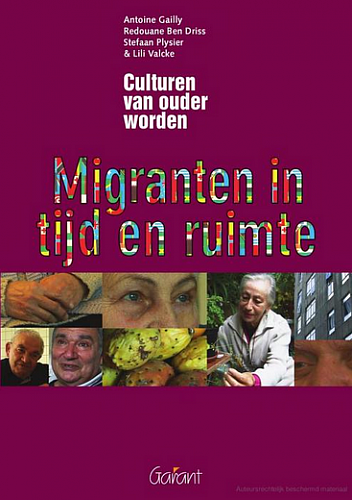Migranten in tijd en ruimte
Culturen van ouder worden
—
Antoine Gailly, Redouane Ben Driss, Stefaan Plysier, and Lili Valcke, Migranten in tijd en ruimte: Culturen van ouder worden [Migrants in time and space: Cultures of ageing]. Antwerpen/Apeldoorn: Garant, 2011. 121 pp., €18.10. ISBN 978-90-441-2830-7.
For older migrants, experiences of loss and alienation in ageing are intensified compared to those who grow old in their own society. They are not only cut off from the time of their youth and middle age, but also from the space and the culture in which they grew up. They furthermore realise that many of the expectations they had regarding their old age may not be fulfilled. The strict rules of filial reciprocity and respect that applied in their country of origin, for example, may not count anymore in their new country where their children have grown up.
Antoine Gailly and his co-authors describe the views and experiences of older migrants in Belgium, and quote extensively from their reflections on how they see themselves in their old age in a ‘foreign’ country. The book (written in Dutch) is a colourful mosaic of narrative fragments that are sometimes grateful and optimistic, but more often sombre and nostalgic.
One limitation of the publication is that information about the research that led to it is missing. The authors do not provide an overview of how many older people, and from which countries, took part in the research. From the cited narratives the reader learns that migrants from at least the following countries are represented (in alphabetic order): Albania, Armenia, Colombia, Congo, Georgia, Iran, Italy, Kosovo, Macedonia, Morocco, Poland, Russia, Rwanda, Spain, Turkey, Ukraine, and Uzbekistan. There is, however, no information on migrants from other countries that one would expect, for example Somalia, Iraq, and Afghanistan. The large number of quotes from Iranian migrants is remarkable, but we do not get any explanation for their strong presence in the book. An overview of the various nationalities of migrants in Belgium would also have been useful to place the narratives in the wider demographic context of Belgian society, where xenophobia is a growing political issue (as in several other European states).
Literature on older migrants often shows significant differences between the perspectives of men and women. Women tend to be more attached to their children whereas men seem to have stronger desires to return to their country of origin. As a second limitation, gender differences are not explicitly mentioned, let alone thematised, in this book. Fortunately, in some cases gender can be deduced from the name (pseudonym?) of the speaker, but in many cases even this form of gender identification is not possible for readers unfamiliar with non-Western names.
Having pointed out some limitations of the study, I nevertheless want to emphasise the richness of the migrants’ narrative reflections. Their words present a lively variety of experiences. Some express feelings of regret and guilt, critique their host society, or complain about bodily decay, loneliness, and fears of being redundant. Others reveal a positive appreciation of Belgium and a joie de vivre thanks to new opportunities, hospitality, and grandchildren. A few examples of this variety:
When the door to my work closed, my life finished.
Everything of old age is ugly.
Getting old leads to suffering, loneliness, neglect.
My body is old, I am not.
Old age does not mean anything to me; I have friends, I visit parties, I go out with my daughter’s friend.
They don’t ask me anymore.
Nobody needs me.
Life was better in the past; there was love.
Home is where my children are.
The only issue on which nearly all older migrants seem to agree is their strong aversion of and resistance to moving into an old people’s home (in Flemish rusthuis, literally ‘rest house’).
The book closes with three life stories (a man from Kosovo, a couple from Turkey, and a woman from Rwanda) and a plea for cultural sensitivity in the study of older migrants. A DVD included with the book contains eight portraits of older migrants; here again the rejection of the rusthuis is prominent.
This publication was delayed due to the unexpected death of the principal investigator and main author, Antoine Gailly (aged 58, see his obituary in Medische Antropologie 21(2):301–04). Three colleagues have completed his work, a worthy tribute to a passionate psychologist and anthropologist.
